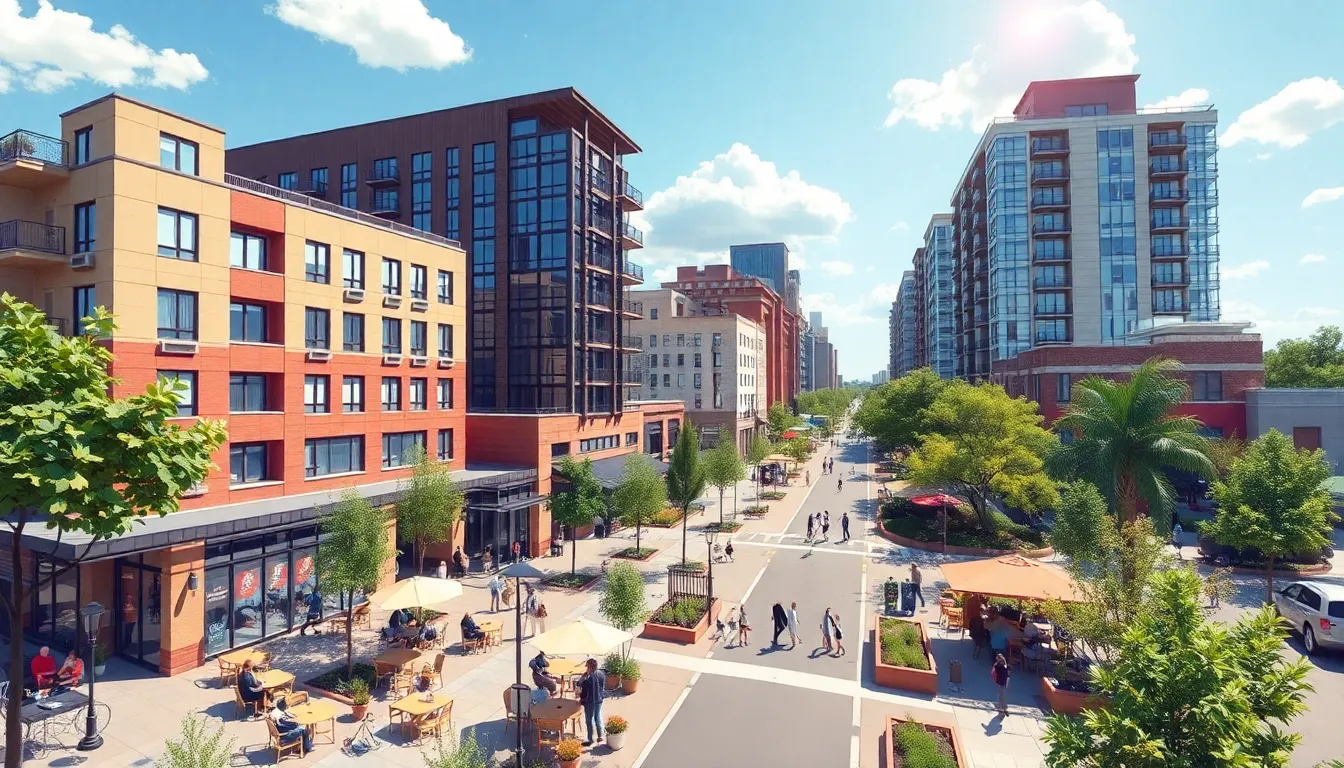Table of Contents
ToggleAustin, Texas is often hailed as the live music capital of the world, but it’s not just the tunes that make it a hot spot. With its vibrant culture and mouthwatering barbecue, many flock to this city. However, before packing up and moving to the land of tacos and tech, it’s crucial to understand the cost of living. Spoiler alert: it might just make you rethink that dream of a spacious downtown loft.
Overview Of Austin TX Cost Of Living
Austin’s cost of living ranks above the national average, making it essential for potential residents to assess their budgets. Housing prices play a significant role, with the median home price around $500,000. Rental costs also reflect this trend, averaging about $1,800 per month for a one-bedroom apartment in the city center.
Food expenses in Austin vary widely, with dining out averaging $15 for an inexpensive meal. Grocery prices remain reasonable, but premium grocery stores can drive up weekly costs. Utility expenses, including electricity, water, and internet, typically amount to $200 per month.
Transportation presents additional considerations for residents. Public transportation, such as buses, costs $1.25 per ride, while owning a car includesgas, insurance, and maintenance. The average commute is approximately 25 minutes, indicating accessibility is a notable factor in living decisions.
Education and childcare expenses also contribute to the overall cost of living. The average monthly fee for daycare services hovers around $1,200 per child. Public schools maintain a strong reputation, often influencing housing demand in specific neighborhoods.
Healthcare costs in Austin align with or slightly exceed national averages. Monthly premiums generally depend on chosen plans and individual needs, so residents should account for this in their budgeting.
Understanding Austin’s cost of living involves examining housing, food, transportation, education, and healthcare. Each factor contributes uniquely, shaping the overall budget for individuals and families considering a move to this vibrant Texas city.
Housing Costs

Housing costs in Austin significantly impact the overall cost of living. Understanding both renting and home buying trends offers insight into the city’s market.
Renting In Austin
Renting in Austin typically entails monthly expenses of around $1,800 for a one-bedroom apartment located in the city center. Areas like East Austin and South Congress often attract renters, as they provide vibrant communities and convenient access to entertainment. Rent prices fluctuate according to location and amenities, with higher prices in trendy neighborhoods. For those looking to save, options exist in nearby suburbs, where rents may average between $1,200 and $1,500. The competitive rental market makes it essential to act quickly when finding a suitable apartment.
Home Buying Trends
Home buying trends in Austin reflect rising prices, with the median home price at approximately $500,000. Fast growth in the tech sector contributes to increased demand, leading to higher property values. Properties in desirable neighborhoods see even steeper prices, often exceeding $700,000. Buyers can find more affordable options outside the city, yet commutes may be longer. Mortgage rates fluctuate, affecting affordability. Potential homeowners need to consider property taxes, which average around 2% of the home’s value, significantly impacting monthly payments.
Transportation Expenses
Transportation expenses in Austin influence the overall cost of living. Public transit and car ownership expenses represent key factors for residents.
Public Transit Options
Public transportation in Austin is accessible and affordable. The Capital Metro system operates buses and the MetroRail, providing coverage throughout the city. A single ride costs $1.25. Monthly passes are available for approximately $41, offering unlimited rides and savings for regular users. Numerous routes cater to popular areas, ensuring convenience for commuters. Additionally, services like Uber and Lyft supplement public transit options for those needing flexible travel. Overall, public transit remains a practical choice for residents and visitors alike.
Car Ownership Costs
Car ownership in Austin also presents notable costs. The expenses include fuel, insurance, and maintenance. Gas prices fluctuate around $3.00 per gallon. Average car insurance rates in Austin reach about $1,500 annually. According to local data, maintenance costs generally average $500 yearly. Parking in the downtown area can be challenging, with many lots charging hourly rates that add up quickly. Those who prefer to drive often face traffic during peak hours, prolonging commute times and contributing to overall transportation costs.
Utilities And Services
Utilities and services contribute to the overall cost of living in Austin. Understanding these expenses helps residents budget effectively.
Average Utility Bills
Average utility bills in Austin hover around $200 per month. This category includes electricity, heating, cooling, water, and garbage services. Residents can expect electricity rates to be competitive, with averages around 11 cents per kilowatt-hour. Water and sewage services typically account for a significant portion of monthly bills. Depending on usage, water expenses may range from $40 to $80 each month. For heating and cooling, factors such as seasonal temperature can lead to fluctuations in energy costs. Reviewing past bills can provide important insights into potential expenses.
Internet And Cable Costs
Internet and cable expenses also factor into the budget for Austin residents. Monthly internet costs average between $60 and $100, depending on the service provider and plan chosen. Fiber optic and cable internet options are available, with speeds ranging from 50 Mbps to 1 Gbps. For those interested in television services, cable packages range from $50 to $150 monthly. Subscribers often find that bundling internet and cable services provides cost savings. Streaming services also present alternatives, with costs typically under $15 per month each. Overall, these options influence the technology budget for households.
Grocery And Dining Expenses
Grocery and dining expenses significantly impact living costs in Austin. While food prices vary, understanding these expenses provides valuable insight for potential residents.
Grocery Prices Comparison
Grocery prices in Austin can range widely. Nationally recognized retailers often offer competitive rates, with basic items like milk averaging about $3.50 per gallon and bread costing around $2.50 per loaf. Organic options may increase these prices, especially at premium grocery stores. In contrast, local farmer’s markets enhance affordability, offering fresh produce at lower costs. Residents seeking savings find that shopping at discount grocery stores can further reduce expenses while still providing quality food.
Restaurant Costs In Austin
Dining out in Austin involves diverse options and varying prices. An inexpensive meal typically costs around $15, while mid-range restaurants may charge about $30 for a three-course dinner for two. Food trucks, a popular choice, often provide delicious meals for less than $10. High-end restaurants cater to those wanting upscale dining experiences, with prices exceeding $50 per person. Because Austin boasts a vibrant food scene, residents enjoy access to a variety of culinary styles, enhancing their dining experience in the city.
Healthcare Costs
Healthcare costs in Austin, Texas, align with national averages, though some expenses may exceed the norm depending on insurance plans and services utilized.
Health Insurance Expenses
Health insurance expenses substantially vary based on coverage options. Monthly premiums can range from $300 to over $600 for individual plans. Employer-sponsored plans often mitigate costs, but the employee’s portion of the premium typically remains higher than average. Additionally, deductibles and co-pays influence the overall price individuals or families pay for healthcare.
Average Medical Costs
Average medical costs in Austin reflect the general trends observed across the country. A doctor’s visit typically costs around $130, while specialist consultations may start at $250. For emergencies, ED visits can escalate quickly, averaging approximately $1,200. Routine services such as lab tests and imaging also contribute to overall costs, with basic blood tests averaging $100 and X-rays costing about $300. Understanding these medical expenses is crucial in planning healthcare budgets effectively.
Navigating the cost of living in Austin requires careful consideration of various factors. While the city’s vibrant culture and lively atmosphere attract many, potential residents must weigh housing costs and everyday expenses against their budget.
With rising home prices and rental rates, it’s crucial to explore options in both the city and surrounding suburbs. Understanding utility costs, transportation expenses, and the price of groceries and dining out can help individuals make informed decisions.
Ultimately, those looking to relocate to Austin should prepare for a competitive market and plan accordingly to enjoy all the city has to offer without breaking the bank.







